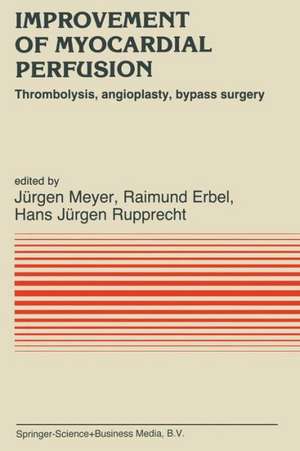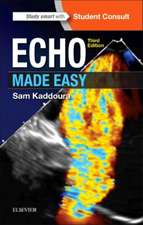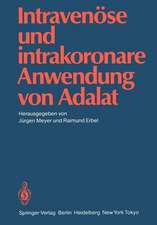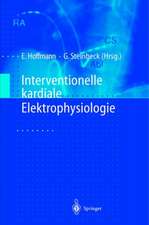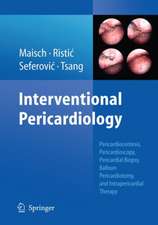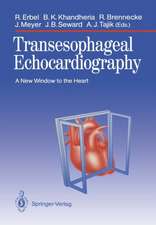Improvement of Myocardial Perfusion: Thrombolysis, angioplasty, bypass surgery: Developments in Cardiovascular Medicine, cartea 50
Editat de J. Meyer, R. Erbel, H.J. Rupprechten Limba Engleză Paperback – 23 aug 2014
Din seria Developments in Cardiovascular Medicine
- 5%
 Preț: 1484.53 lei
Preț: 1484.53 lei - 5%
 Preț: 375.17 lei
Preț: 375.17 lei - 5%
 Preț: 354.10 lei
Preț: 354.10 lei - 5%
 Preț: 1419.03 lei
Preț: 1419.03 lei - 5%
 Preț: 376.43 lei
Preț: 376.43 lei - 5%
 Preț: 1098.27 lei
Preț: 1098.27 lei - 5%
 Preț: 1438.38 lei
Preț: 1438.38 lei - 5%
 Preț: 376.78 lei
Preț: 376.78 lei - 5%
 Preț: 368.37 lei
Preț: 368.37 lei - 5%
 Preț: 380.25 lei
Preț: 380.25 lei - 5%
 Preț: 2117.58 lei
Preț: 2117.58 lei - 5%
 Preț: 367.28 lei
Preț: 367.28 lei - 5%
 Preț: 366.56 lei
Preț: 366.56 lei - 5%
 Preț: 371.10 lei
Preț: 371.10 lei - 5%
 Preț: 370.94 lei
Preț: 370.94 lei - 5%
 Preț: 783.18 lei
Preț: 783.18 lei - 5%
 Preț: 713.18 lei
Preț: 713.18 lei - 5%
 Preț: 1098.27 lei
Preț: 1098.27 lei - 5%
 Preț: 375.49 lei
Preț: 375.49 lei - 5%
 Preț: 373.47 lei
Preț: 373.47 lei - 5%
 Preț: 723.93 lei
Preț: 723.93 lei - 5%
 Preț: 1104.13 lei
Preț: 1104.13 lei - 5%
 Preț: 2117.20 lei
Preț: 2117.20 lei - 5%
 Preț: 716.09 lei
Preț: 716.09 lei - 5%
 Preț: 372.03 lei
Preț: 372.03 lei - 5%
 Preț: 722.33 lei
Preț: 722.33 lei - 5%
 Preț: 660.07 lei
Preț: 660.07 lei - 5%
 Preț: 375.34 lei
Preț: 375.34 lei - 5%
 Preț: 1423.22 lei
Preț: 1423.22 lei - 5%
 Preț: 715.35 lei
Preț: 715.35 lei - 5%
 Preț: 790.69 lei
Preț: 790.69 lei - 5%
 Preț: 720.68 lei
Preț: 720.68 lei - 5%
 Preț: 3185.49 lei
Preț: 3185.49 lei - 5%
 Preț: 1418.27 lei
Preț: 1418.27 lei - 5%
 Preț: 784.64 lei
Preț: 784.64 lei - 5%
 Preț: 714.63 lei
Preț: 714.63 lei - 5%
 Preț: 370.74 lei
Preț: 370.74 lei - 5%
 Preț: 376.22 lei
Preț: 376.22 lei - 5%
 Preț: 660.85 lei
Preț: 660.85 lei - 5%
 Preț: 368.37 lei
Preț: 368.37 lei
Preț: 373.68 lei
Preț vechi: 393.35 lei
-5% Nou
Puncte Express: 561
Preț estimativ în valută:
71.51€ • 74.38$ • 59.04£
71.51€ • 74.38$ • 59.04£
Carte tipărită la comandă
Livrare economică 15-29 aprilie
Preluare comenzi: 021 569.72.76
Specificații
ISBN-13: 9789401087292
ISBN-10: 9401087296
Pagini: 388
Ilustrații: XVIII, 366 p. 110 illus.
Dimensiuni: 155 x 235 x 20 mm
Greutate: 0.54 kg
Ediția:Softcover reprint of the original 1st ed. 1985
Editura: SPRINGER NETHERLANDS
Colecția Springer
Seria Developments in Cardiovascular Medicine
Locul publicării:Dordrecht, Netherlands
ISBN-10: 9401087296
Pagini: 388
Ilustrații: XVIII, 366 p. 110 illus.
Dimensiuni: 155 x 235 x 20 mm
Greutate: 0.54 kg
Ediția:Softcover reprint of the original 1st ed. 1985
Editura: SPRINGER NETHERLANDS
Colecția Springer
Seria Developments in Cardiovascular Medicine
Locul publicării:Dordrecht, Netherlands
Public țintă
ResearchCuprins
I. Acute myocardial infarction.- 1. Systemic streptolysis of acute myocardial infarction.- 2. Efficacy of BRL 26921, a new fibrinolytic agent for intravenous infusion, in acute myocardial infarction.- 3. Coronary venous retroperfusion support of reperfusion following acute coronary occlusion.- 4. Elevation of coronary sinus pressure improves myocardial protection.- 5. Improvement of myocardial perfusion and enhancement of washout during coronary artery occlusion by intermittent pressure controlled coronary sinus occlusions.- 6. Medical-mechanical treatment of myocardial infarction.- 7. Autopsy findings in 14 patients with myocardial infarction treated with thrombolysis or combined thrombolysis and PTCA.- 8. Thrombolytic therapy in myocardial infarction: are fibrinolytic drugs comparable, and similarly effective?.- 9. Coronary thrombolysis with tissue-type plasminogen activator (t-PA).- 10. Financial background of PTCR and PTCA and regional distribution of cardiac catheterization laboratories in the Federal Republic of Germany.- II. Evaluation of improvement of myocardial perfusion.- 11. Natural history of coronary artery stenosis.- 12. ECG and reperfusion.- 13. Intracoronary myocardial scintigraphy during intracoronary thrombolysis.- 14. Opposite ends of the intervention spectrum: effects of intracoronary thrombolysis on long-term survival and LV function — Detection of early CAD by non-invasive positron imaging.- 15. Improvement of myocardial perfusion by thrombolysis evaluation of left-ventricular function by two-dimensional echocardiography.- 16. Right ventricular infarction: echocardiographic and hemodynamic feature.- 17. Limitation of myocardial necrosis by thrombolysis during acute myocardial infarction.- III. Percutaneous transluminal coronary angioplasty.- >A.Pathophysiology.- 18. Pathophysiology of transluminal angioplasty.- 19. Does angioplasty improve or accelerate atherosclerosis?.- B. Myocardial function during PTCA.- 20. Elective PTCA of totally occluded coronary arteries not associated with acute myocardial infarction: short and long-term results.- 21. Acute changes of myocardial function by PTCA. Evaluation by two-dimensional echocardiography.- 22. Coronary sinus potassium and pH during percutaneous transluminal angioplasty: temporal relation to contractility and action potential duration.- 23. Validity of myocardial scintigraphy, measurement of pulmonary artery pressure and intravenous digital subtraction angiocardiography in the evaluation of the effect of PTCA.- 24. Monitoring of myocardial ischaemia during PTCA improved sensitivity with 12-lead ECG.- 25. Results of percutaneous transluminal coronary angioplasty assessed by TL-201 perfusion scintigraphy.- 26. Automated computer-assisted quantitative assessment of stenosis geometry and hemodynamics pre and post PTCA.- 27. Relationship of the occlusion pressure during PTCA to collaterals.- 28. Changes in creatine phosphokinase after coronary angioplasty.- 29. Antiischemic properties of intracoronary diltiazem.- 30. Cardio-computertomography for assessing regional myocardial perfusion abnormalities in coronary heart disease.- 31. Clinical significance of microsphere myocardial scintigraphy in coronary artery disease.- C. Clinical results.- 32. Current aspects of transluminal coronary angioplasty.- 33. Treatment of unstable angina by transluminal coronary angioplasty PTCA.- 34. Coronary angioplasty in multivessel disease.- 35. Effect of coronary occlusion during percutaneous transluminal angioplasty on systolic and diastolic left ventricular function.- 36. Restenosisfollowing successful coronary angioplasty (PTCA): the result of inadequate dilatation? — Relation between primary success and late results.- 37. Results of repetitive controls after successful transluminal coronary angioplasty.- 38. Long-term results after angioplasty of stenosed coronary artery bypass grafts.- 39. In vitro studies to investigate the possibility of protective intracoronary perfusion during percutaneous transluminal coronary angioplasty (PTCA).- 40. Haemodynamic and haemorheology effects of intracoronary perfusion during percutaneous transluminal coronary angioplasty (PTCA).- 41. Improved tolerance of intracoronary balloon inflation with a modified Grüntzig balloon angioplasty catheter.- 42. Pressure transmission characteristics of the Grüntzig superlow-profile catheter.- 43. Increased hemolysis during coronary perfusion via angioplasty catheters as a result of side-hole jet effect.- IV. Coronary artery surgery.- 44. Intraoperative angioplasty in the treatment of coronary artery disease.- 45. Treatment of coronary artery stenosis by laser technique.- 46. Reoperative myocardial revascularization.- 47. Aortocoronary polygrafting and coronary endarterectomy in diffuse CAD.- 48. Coronary artery bypass in the elderly.- 49. Combination of valve replacement and coronary bypass.- 50. Cardiac valve replacement and simultaneous myocardial revascularization.- 51. Bypass surgery for stenosis and occlusion of the left main coronary artery.- 52. Bypass surgery adjacent to streptolysis therapy.- 53. Emergency bypass operation after PTCA.- 54. Massive coronary artery spasm with resultant myocardial infarction after ACVB — surgery. A case report.- Index of subjects.
